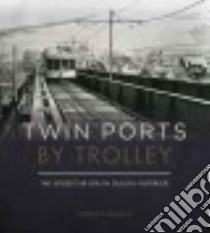Twin Ports by Trolley - 9780816673087
Un libro in lingua di Aaron Isaacs edito da Univ of Minnesota Pr, 2014
- € 35.70
- Il prezzo è variabile in funzione del cambio della valuta d’origine
An international seaport and an industrial powerhouse, Duluth was a natural for streetcar service, but making it successful was a challenge. The city, some twenty-five miles long yet only three miles wide in most places, has the tallest and steepest hills in Minnesota and a harbor separating it from its sister city, Superior, Wisconsin. Twin Ports by Trolley charts the history of the streetcar system that met the unique difficulties posed by Duluth, from the Interstate Bridge that crossed the harbor to the Incline Railway that carried travelers more than five hundred feet above Lake Superior.
Following the rails as horse-drawn cars gave way to electric trolleys, Aaron Isaacs takes us into the workings of the Duluth–Superior streetcars: politics and corporate maneuvers, engineering and maintenance, scheduling and setting routes, running and riding the trolleys. Along the way we meet motormen and conductors (including twenty-one women who stepped in during World War I) and learn what it’s like to run a streetcar through obstacles ranging from heavy snowstorms to Halloween pranks to the heroism of evacuating a burning neighborhood. Then we ride the rails in a typical car, with a floor of varnished wood and seats of cushioned rattan, and a not-so-typical luxury car, outfitted to the nines with velvet curtains and a bar for lucrative “streetcar parties.” We experience the ride, whether buying a token or braving the smokers on the rear platform when boarding, and we learn the routes as the streetcars deliver, along with passengers, mail pouches and newspapers, dogs, and, in the case of the Park Point funeral car, corpses and mourners. Isaacs traces traffic patterns and geographic features for each line and describes imaginary trips on three of the most interesting routes.
The book is, finally, a tour of the Twin Ports over time, with a wealth of maps and photographs illustrating routes and landmarks and picturing the people who made the rails hum. Interviews and newspaper features, “day-after reports” and management memos, stories told by employees and onlookers—all contribute to a rich evocation of a fascinating historical era. The streetcars are long gone from Duluth and Superior, but remnants survive if one knows where to look—and this street-level exploration points the way.
Informazioni bibliografiche
- Titolo del Libro in lingua: Twin Ports by Trolley
- Sottotitolo: The Streetcar Era in Duluth-Superior
- Lingua: English
- Autore: Aaron Isaacs
- Editore: Univ of Minnesota Pr
- Collana: Univ of Minnesota Pr (Hardcover)
- Data di Pubblicazione: 25 Ottobre '14
- Genere: Lingua Inglese
- Argomenti : Street-railroads Minnesota Duluth History Street-railroads Wisconsin Superior History Street-railroads Rolling stock Minnesota Duluth History
- Pagine: 342
- Dimensioni mm: 254 x 228 x 38
- EAN-13: 9780816673087


